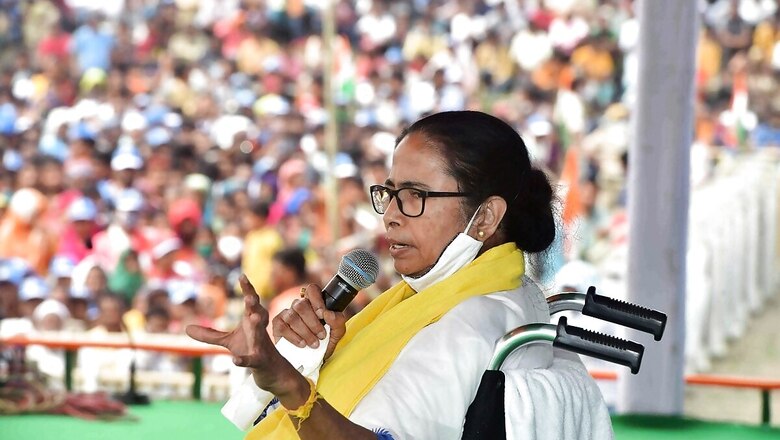
views
Animesh Bera, a security guard at an ATM facility near the office of Nandigram community development block II, sounded satisfied with the Mamata Banerjee government’s efforts to cover the basic needs of the downtrodden. A resident of the area, Bera, who is in his late 20s, is a staunch supporter of the West Bengal chief minister and is ready to give her another term to create job opportunities. “Now that she has covered the basic needs, she should focus on employment generation this time,” he said.
However, among people of his age group, few have Bera’s optimism on Mamata Banerjee’s rule. “We want change because we want jobs, not doles,” was a common theme in what the youths in their 20s and 30s, living in distant areas like the Sundarbans in the southeast, Jangamlahal in the southwest, the hills in north Bengal and Kolkata’s suburban districts like Hooghly and North 24 Parganas, told this writer in recent months.
A large majority of them was banking on the Bharatiya Janata Party (BJP) to usher in a new era of industrial development in the state.
And here is where the assembly election of 2021 is different from the Lok Sabha polls of 2019. Two years ago, Banerjee’s Trinamool Congress, popularly known as the TMC, was facing the anger of the masses for having turned the 2018 panchayat elections into a mockery of democracy, adopting myriad ways to ensure an election without contests and panchayat boards without opposition. A rising wave of Hindu nationalism since 2017 and the BJP’s strength as a national party as compared to the TMC’s other opponents – the Left and the Congress – helped the BJP consolidate the anti-incumbency in its favour. Now, the aspirations for a government with pro-industrialisation approach adds to the BJP’s prospects.
Soon after the Lok Sabha election jolt, the TMC, in consultation with political strategist Prashant Kishor’s organisation Indian Political Action Committee (I-PAC), chalked out course-corrective measures. To reduce people’s anger, the faces of the party at the grassroots level were changed in many places, besides organising public outreach programmes on behalf of the party (Didi Ke Bolo) and the government (Duarey Sarkar). To deal with the Hindu consolidation in favour of the BJP, which happened as a result of a concerted campaign by the saffron party and various organisations belonging to the Rashtriya Swayamsevak Sangh (RSS) family branding her government as anti-Hindu, Mamata Banerjee and other leaders of the Trinamool Congress started highlighting their Hindu identity.
As a result of these measures, the localised anger against the TMC for misgovernance – including corruption, nepotism and high-handedness – seemed to have reduced, compared to what it was ahead of the 2019 parliamentary polls. But the perception of the government as one that prioritised the well-being of the minorities over that of the majority Hindus seemed to have grown only stronger, despite all the TMC’s overtures towards the religious Hindus.
Amidst these changing dynamics, the emergence of ‘positive votes’ in the BJP’s favour – as compared to the ‘negative votes against TMC’ in 2019 – has further complicated the equations for the state’s ruling party.
Of the aspiring youth, most did not have many complaints against the Mamata Banerjee government and were not concerned with price rise either. They believed that the state needed a rapid industrialisation drive to generate employment and that the BJP was the best party when bringing industries was the issue.
“The BJP has a pro-industrialisation image. Besides, they are in power at the Centre. If it comes to power in the state, it is likely to manage to draw investments by creating a pro-industrialisation atmosphere,” Biplab Rajbanshi, a 27-year-old living in Alipurduar town of north Bengal, told this writer. Until the Covid-related lockdown in 2020, he used to spend the better part of a year in the coastal states of Kerala and Tamil Nadu, working in the marine fishing industry.
Interstate migration is common in many states of India but the extent of such migration from West Bengal – as revealed during the return of migrants after the Covid-19 lockdown last year – created an impression that the employables in Bengal had little opportunity.
Rajbanshi echoed the sentiments of many in his age group. They were not only from the urban middle-class but also from rural areas and lower-middle-class families.
It seemed to be the same aspirations that the Left Front attempted to tap into while deciding on its 2006 assembly election slogan, “Krishi Amader Bhitti, Shilpo Amader Bhobishyot,” which meant, “Agriculture makes our foundation, while the future lies in industries.” After winning the elections with an overwhelming mandate, it tried to implement the policy by planning mega industrial projects in Singur, Nandigram and Salboni. But mass agitations over attempted forcible eviction of farmers brought the government’s downfall, and Mamata Banerjee, since assuming power in 2011, dealt with the issue of land very sensitively.
While its policy on land acquisition earns the TMC government the trust of a large section of the peasantry, even a section of the youth from families with agricultural background seem to consider the party incapable of carrying out an industrialisation drive.
“Industrialisation is not the TMC’s ball game,” summed up Anindya Banerjee while explaining why he preferred the BJP over the TMC for employment generation.
The Trinamool Congress has consistently in its campaign accused the Narendra Modi government at the Centre of failing to prevent job losses across the country over the past few years, besides citing various data to prove the unemployment rate in the state improved after the Left regime and was in a better position than many BJP-ruled states. But these seemed to have had little impact on Banerjee, a 24-year-old engineering graduate and job aspirant who lives near Dutta Para Durga Mandir in Baruipur town of South 24 Parganas district and earns his living as a private tutor.
Mamata Banerjee did sense the emergence of such sentiments. Since 2019, she has started highlighting the planned mining projected in Birbhum district around the Deocha-Pachami coal block, being projected as Asia’s largest repository of coal, pegging the project as a game changer in creating job opportunities. The government was keen on starting the preliminary work before the 2021 assembly elections. But the situation over Covid-19 for the most part of 2020 stalled the plan. Activities around it could have been the government’s best bet in winning over these graduates and postgraduates who are looking for better-salaried jobs inside the state.
Having lost that opportunity, the TMC’s campaign, too, has focussed little on bringing in major industrial projects.
Speaking of the aspirations, the BJP’s theory of the benefits of a “double engine government”, meaning the same party’s government in the state and at the Centre, seemed to have played a role in its building.
It was during 1972-77 that the state had the same party’s government as in the Centre for the last time. Thereafter, the Centre had a Left-backed government between 2004 and 2008 when the Left ruled in the state and a TMC-backed government in 2011-12 when the TMC ruled the state.
“We have seen the result of having different party’s governments (in the state and Centre). Bengal’s industrial fortune did not improve. Let’s for once see if the same party’s government improves the scene,” was another reason that prospective BJP voters cited behind their choice.
In short, in 2019, people voted for the BJP without any expectation from it; they wanted to teach a lesson to the TMC, or its local leaders to be precise. In 2021, many will be voting for the BJP with expectations. And for the TMC, merely addressing the issues behind its 2019 electoral debacle may not help the party sail through, as the reasons behind the BJP’s popularity have changed.
(Snigdhendu Bhattacharya is a Kolkata-based journalist and author of the recently-published book, ‘Mission Bengal: A Saffron Experiment’. Views expressed are personal.)
Read all the Latest News, Breaking News and Coronavirus News here. Follow us on Facebook, Twitter and Telegram.




















Comments
0 comment